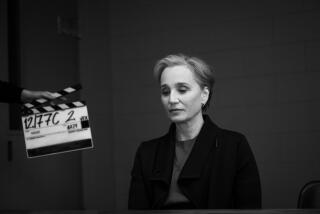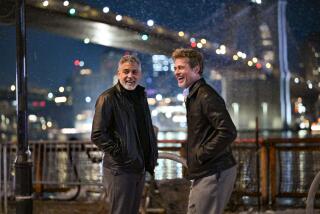Tony Scott dies at 68; a film career in retrospective
Director-producer Tony Scott, who apparently committed suicide Sunday in San Pedro at age 68, left behind a lengthy filmography.
One of the first directors to make the transition from commercials to features, he helmed movies including “Top Gun,” “Beverly Hills Cop II” and “Unstoppable” and served as producer or executive producer on many other movies, including this summer’s “Prometheus,” directed by his older brother, Ridley Scott.
Here’s a look back at some of his best-known works, with clips where available.
“Top Gun” (1986)
Tony Scott was hardly a hot commodity in Hollywood when he landed the director’s gig for this now-classic starring Tom Cruise, Val Kilmer and Meg Ryan about the Navy’s crack fighter pilot program at San Diego’s Miramar Naval Base. Despite middling reviews – Times critic Michael Wilmington called it an “empty-headed technological marvel” -- the movie grossed $176 million at the domestic box office – or more than $380 million in today’s dollars.
Scott had had great success directing TV commercials, but his first film, “The Hunger”— a story about vampirism starring Catherine Deneuve and David Bowie--proved a flop.
In a 1986 interview with The Times, he recounted how he was drafted for “Top Gun,” even though “Hunger” had failed and even though he knew nothing about the prestigious Fighter Weapons School, where the top American pilots are trained. Scott said he first learned about the project in 1984 when he was on a raft trip on the Colorado River with a group that included producers Don Simpson and Jerry Bruckheimer (who would become repeat collaborators).
At that time, Simpson and Bruckheimer had another director in mind for “Top Gun,” and Scott himself was preparing the film “Man on Fire,” which he hoped Robert Duvall would do. (Nearly two decades later, Scott would eventually do “Man on Fire,” with Denzel Washington in the lead.)
“I remember listening to Don and Jerry and thinking what a good idea it sounded,” Scott said. “But at that point another director was involved.”
When negotiations with Duvall broke down, Scott said, a new actor was approached, and he wanted changes. “I could see another year’s work looming ahead of me. And then, out of the blue, Don and Jerry approached me about making ‘Top Gun.’ And I jumped at it.”
“Beverly Hills Cop II” (1987)
Following on the success of “Top Gun,” Scott again teamed with Simpson and Bruckheimer in 1987, for the sequel to Eddie Murphy’s “Beverly Hills Cop.” It would become his second biggest hit as a director, taking in $153 million domestically.
Directing “Cop II” was a fulfillment of his wish to do a comedy and to work with Eddie Murphy, Scott told The Times after its release. However, he did have a few misgivings. “As a director, I was ambivalent about taking on a sequel, and the film was a daunting prospect because the original had been so successful. But I loved Eddie and the boys and felt I could do a different movie.”
Spurning critics’ complaints that his movie was only a clone of the original, Scott said his “Cop” was “much tougher, faster and glossier. I tried a different focus on the characters. I capitalized on their redevelopment, especially of Rosewood (Judge Reinhold). Plus, I think I made this one more contemporary.”
He rejected suggestions that he had somehow sold out by doing two such commercial films back-to-back. “I don’t see it that way,” Scott said. “I think I’ve been lucky. Thanks to (producers) Don (Simpson) and Jerry (Bruckheimer, who also produced “Top Gun”), I’ve been able to do two hard-core entertainment films that are each different. The similarity is that the passion I brought to both was the same; making a film to me is like fighting a war.”
“True Romance” (1993)
Scott took a much darker turn directing the Quentin Tarantino-scripted “True Romance,” which followed Tarantino’s breakout “Reservoir Dogs.” “Romance” starred Christian Slater as a mild-mannered comic-book store employee, Clarence, who falls for a hooker named Alabama, played by Patricia Arquette. Their love heats up, a drug deal goes bad, and the pair head out for California in a large purple Cadillac. (The film also featured “Top Gun’s” Val Kilmer plus Dennis Hopper, Gary Oldman, Brad Pitt, Christopher Walken, Chris Penn, Michael Rapaport, Tom Sizemore, Samuel L. Jackson, and James Gandolfini, who would later be seen in Scott’s “Crimson Tide” and “The Taking of Pelham 123”.)
Janet Maslin of The New York Times called the movie “a vibrant, grisly, gleefully amoral road movie directed by Tony Scott and dominated by the machismo of Quentin Tarantino,” adding that it was sure to offend a good-sized segment of the moviegoing population.” Despite this and other positive reviews, the film bombed commercially, taking in less than $13 million.
“Crimson Tide” (1995)
A military thriller that combined the deep-dive tension of “The Hunt for Red October” and the jousting-with-authority scenario of “A Few Good Men,” the axis of the film is the duel of wills between a fire-breathing submarine commander (Gene Hackman) and his new second-in-command (Denzel Washington), who believes that in a nuclear world, war itself is the enemy.
Scott brought Tarantino in to add ping to the submarine crew’s dialogue, and the cast was a deep one, with Viggo Mortensen, Gandolfini and Rick Schroder.
“Enemy of the State” (1998)
Hackman and Will Smith team up for Scott’s highest-grossing film after his 1980s glory days with Cruise and Murphy. The movie is a sort of unofficial sequel to “The Conversation,” the 1974 Francis Ford Coppola film that starred Hackman as a surveillance specialist who gets his wires crossed.
Los Angeles Times critic Kenneth Turan said Scott delivered on a tale of Big Brother themes: “Collaborating with cinematographer Dan Mindel, he does a compelling job of visualizing how satellites and computers could make this Truman-Show-for-real scenario actually happen…Scott also pays attention to the acting and it pays off.”
“Man on Fire” (2004)
About two decades after he first contemplated making “Man on Fire,” Scott brought the project to fruition with Washington in the lead, and the action set in Mexico. Washington played Creasy, a disillusioned counterterrorism vet who strikes up a bond with a child (Dakota Fanning) he’s hired to protect from kidnapping.
Reviewing the film, Times critic Turan noted that Scott was a “director known to showcase lots of things blowing up and lots of people being blown away” and that “the visual component is always a key focus of his work. But when he’s had interesting material to work with, as he did in ‘Enemy of the State’ and ‘Crimson Tide,’ he’s made good use of it, and he has a similar opportunity here. … Scott has turned out a film that is, unlikely as it sounds, initially more a character study than anything else.” The film went on to gross nearly $78 million domestically.
“Déjà Vu” (2006)
The third teaming of Scott and Washington was this thriller with a do-over twist. Washington portrayed a federal agent who, thanks to an experimental technology, gets a chance to go back and stop a New Orleans ferry disaster before it takes a single life.
Washington said he didn’t mind déjà vu when it came to working with Scott. “I really enjoy working with Tony, so it makes for a pleasurable experience. I’ve been at this too long for it not to be fun. It’s sort of a no-brainer. The next time they call me, I’ll be there.”
“The Taking of Pelham 123” (2009)
Scott endured some criticism for his “reinvention” of the 1974 thriller, which was widely considered one of the decade’s classic films. But in the post-9/11 era, Scott felt there was something new that could be done with terrorist dramas.
Scott replaced Walter Matthau’s wisecracking transit police lieutenant with Washington, while John Travolta nabbed the lead terrorist part that an icy Robert Shaw inhabited in the original. Gandolfini portrayed the new movie’s beleaguered mayor.
The new film showcased contemporary technologies: live-blogging, webcams and online commodity trading in pursuit of a criminal vendetta.
“Unstoppable” (2010)
The rare action film without guns, swords or brutality, “Unstoppable” earned the filmmaker some of his best reviews with its tense and artfully choreographed tale of a half-mile-long freight train barreling toward a city at 70 mph with no one aboard.
The movie teamed Scott yet again with Washington, who plays a veteran engineer whose style clashes with a rail newcomer played by “Star Trek” star Chris Pine.
“The Hunger” (1983)
So what about that first movie, “The Hunger,” that flopped so badly in 1983, and nearly derailed Scott’s film career before it even started?
Just as Ridley Scott made his mark with a jarring, visceral and stylized horror film--namely “Alien” in 1979--his brother did the same, but he went for the throat instead of the gut. “The Hunger” is the tale of an ancient vampire named Miriam (Deneuve) and her fading partner, John (Bowie), who seeks help from a medical researcher named Sarah (Susan Sarandon).
The movie became notorious for Miriam’s dreamy seduction of Sarah, but that wasn’t enough to keep the blood pumping for many critics. Roger Ebert wrote at the time: “’The Hunger’ is an agonizingly bad vampire movie, circling around an exquisitely effective sex scene.”
ALSO:
PHOTOS: Tony Scott | 1944-2012
PHOTOS: Hollywood reacts to Tony Scott’s death
‘Top Gun’ director Tony Scott dead after jumping off bridge
More to Read
Only good movies
Get the Indie Focus newsletter, Mark Olsen's weekly guide to the world of cinema.
You may occasionally receive promotional content from the Los Angeles Times.











